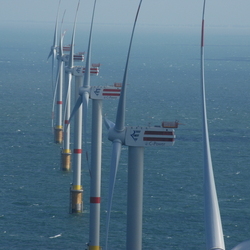 The U.S. Department of Defense (DOD) has often had an uneasy relationship with wind turbines since the earliest California machines were installed in the 1980s, as operating wind turbines can be indistinguishable from airplanes on many radar systems and cause blackout zones in which planes disappear from radar entirely.
The U.S. Department of Defense (DOD) has often had an uneasy relationship with wind turbines since the earliest California machines were installed in the 1980s, as operating wind turbines can be indistinguishable from airplanes on many radar systems and cause blackout zones in which planes disappear from radar entirely.
David Belote, executive director of the DOD's energy-siting clearinghouse, tells NAW that wind turbines can negatively impact several areas of defense operations, such as border surveillance, flight training and military readiness. In addition, clusters of wind turbines look similar to storm activity on weather radar, making it harder for air traffic controllers to convey information to pilots.
‘It really depends on the specific military mission as to what the radar impact would be,’ he says.
Recently, the DOD had serious concerns with the massive Shepherds Flat wind project in Oregon, and the Pentagon asked that more studies be conducted before the project was allowed to continue. ‘We were unprepared at Shepherds Flat,’ explains Belote.
Also of concern for the DOD is offshore wind development in Virginia. As the state moves closer to attaining its offshore wind goal, the DOD will almost certainly have some issues with the wind turbines. However, Belote says that the department is mindful of the state's offshore wind plans.
‘Virginia's state task force studying offshore wind has dug in deep into that process,’ he says. ‘They have studied the issue down to sixteenths of an acre.’
Industry watchers, such as Jim Lanard, executive director of the Offshore Wind Development Coalition, maintain that offshore wind and DOD activities can peacefully coexist.
‘The Department of Defense, and particularly the Department of the Navy, has strongly endorsed offshore wind,’ Lanard says. ‘There are security issues that the DOD does need to consider, and we are mindful of that. We hope that the DOD will be able to be flexible as they decide where offshore wind farms can be located off the Virginia coast.’
Also at stake, Lanard says, is economic development potential. He says Virginia's port facilities could play a vital role in the development of the offshore industry and the creation of thousands of associated jobs.
‘However, those ports and nearby sites won't likely be developed if significant swaths of land on the Outer Continental Shelf off the coast of Virginia are closed to offshore wind developers,’ he explains.
Rather than simply fighting wind turbines, the DOD is now actively studying how the turbines and radar can coexist.
‘A lot of these issues are solvable with technology and money,’ Belote says, explaining that gap-filler technology used in 2008 and 2009 was able to mask radar interference at the Travis Air Force Base (AFB) in California from a nearby wind farm. Travis AFB was especially challenging, he recalls, because there are more than 800 wind turbines within four miles of the base.
So-called gap-filler technology, he says, acts as a patch on radar systems at the base. It is used in conjunction with radar from Sacramento and Stockton, which is piped into Travis's radar processor and display.
‘The returns from the additional radars don't show up on the Travis screen unless the controller specifically commands so,’ Belote says. ‘[The radars] remain in the processor's memory, so it retains a track file as long as one of the three radars can see the return.’ That way, he says, aircraft do not suddenly disappear on a radar screen.
To replicate the success found at Travis AFB, Belote says several governmental agencies, such as the Federal Aviation Administration and the Departments of Energy, Interior and Homeland Security, are also studying the issue.
Belote says the DOD is looking to contribute $3 million toward the $6 million needed over the next two fiscal years. Additionally, he says, the Department of Homeland Security is working on a separate but related program with Raytheon to alleviate radar concerns.



